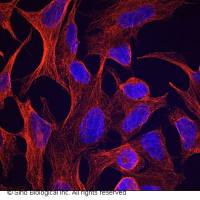In Vitro Reconstitution of the MHC Class I Peptide-Loading Complex
互联网
726
The stability of the MHC (major histocompatibility complex) class I peptide repertoire is optimized during assembly in the endoplasmic reticulum (ER) and depends on the collective function of components of the peptide-loading complex (PLC). The chaperone-like molecule tapasin is the cornerstone of this complex and acts directly on the MHC class I molecule to promote high-affinity peptide loading. Optimal tapasin activity, however, relies on the ability of ERp57 and calreticulin, two proteins involved in general ER glycoprotein folding, to bridge and thereby stabilize its otherwise weak interaction with the MHC class I heavy chain. Here, we describe methods for the recombinant expression of soluble components of the PLC specifically tailored to generate the post-translational modifications required to support subcomplex assembly in vitro. Using recombinant MHC class I molecules bearing monoglucosylated N-linked glycans, calreticulin, and disulfide-linked tapasin/ERp57 heterodimers, this soluble PLC subcomplex can be employed to study the mechanism of peptide loading or the principles governing peptide selection for particular MHC class I alleles.









